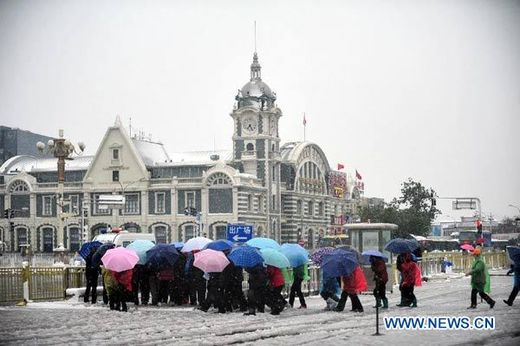
China has a four-tier color-coded snow warning system: red, orange, yellow and blue, red being the most serious.
By 10 a.m. on Sunday, the capital had received an average daily precipitation of over 58 mm, a post-1951 record for the city during China's Nov.-March winter period, according to the Beijing Meteorological Center.
In the Fenghuangling region of Haidian District, the snowfall has lasted for over 40 hours and brought the maximal precipitation to 96 mm.
"With a complicated distribution of precipitation, this process is bringing greatly different effects to citizens living in various regions of such a a large city," said Sun Jisong, the center's chief forecaster.
The west of Beijing has mainly received blizzards, while the city's eastern urban areas have been lashed with freezing rain and snow, said Sun.
Blizzards brought by the strong wind whipped through the city's western regions. And the accumulated snow reached knee-height, said posters on Sina Weibo, China's leading Twitter-like microblogging service.
"The snow covering on roads has accumulated to 40 cm, and hundreds of vehicles have been stranded for over 12 hours on the Badaling road section of the Beijing-Tibet expressway while rescuers are clearing the road," read one post.
Following the blizzard warnings, Beijing also released a citywide icy road alert and orange alert for its western regions.
Beijing traffic authorities have started the highest level of traffic safeguard plan in snowy weather to ease tailbacks and close some expressway sections.
The capital's traffic management bureau has allotted all its 7,000 traffic police to patrol roads and direct the traffic flow.
To fight the persisting strong cold spell, Beijing has switched on the city's public heating ahead of the scheduled Nov. 15.
As of 10 a.m. on Sunday, over 96 percent of the capital's buildings have been supplied with heating, 12 days ahead of annual routine.
In addition, 31 repair teams with over 1,200 rescuers are ready for emergencies and faults with heating supply.
China on Sunday also continued to warn against blizzards in northern regions, hiking the alert to the second-highest level on snowstorms that are expected to arrive over the next few days.
On Sunday and Monday, heavy snow will hit central and eastern parts of Inner Mongolia Autonomous Region, northern and western parts of Hebei Province, and most parts of Beijing, with some regions seeing snowstorms reaching 30 mm, the National Meteorological Center said.
The meteorological station in east China's Shandong Province on Sunday morning issued its first blue warning on the cold wave this year, and continued to issue a yellow alert on winds whipping in from the sea.
In the 24 hours leading up to 8 a.m. on Sunday, all 17 cities in Shandong received snow and rain, with an average precipitation of 28.4 mm.
This precipitation will effectively ease the area's drought and be helpful for crops in the province, China's major agricultural producing area.



Reader Comments
to our Newsletter